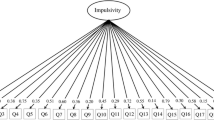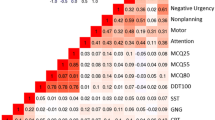Abstract
Impulsivity is central to several psychopathological states in adolescence. However, there is little consensus concerning the definition of impulsivity and its core dimensions. In response to this lack of consensus, Whiteside and Lynam (2001, Pers. Individ. Differ. 30, 669–689) have developed the UPPS Impulsive Behavior Scale, which is able to distinguish 4 dimensions of impulsivity in adults: Urgency, lack of Premeditation, lack of Perseverance, and Sensation seeking. The question arises of whether these 4 dimensions also exist in adolescents and also of whether gender differences can be observed. A sample of teenagers (314 girls and 314 boys) completed a French version of the scale (Van der Linden et al., Eur. J. Psychol. Assess., 2005). Based on exploratory and confirmatory analyses, the 4-factor model is replicated in girls, boys, and the whole sample. Concerning gender differences, girls have a higher score for Urgency and boys a higher score for Sensation seeking. Overall, this study suggests that the UPPS is a promising tool for studying impulsivity in adolescence.
Similar content being viewed by others
References
Barratt, E. (1985). Impulsiveness subtraits: Arousal and information processing. In Spence, J., and Izard, C. (eds.), Motivation, Emotion, and Personality. Elsevier Science, Amsterdam, pp. 137–146.
Bongers, I. L., Koot, H. M., Van der Ende, J., and Verhulst, F. C. (2003). The normative development of child and adolescent problem behavior. J. Abnorm. Psychol. 112: 179–192.
Byrne, B. M. (1994). Structural Equation Modeling With EQS and EQS/Windows. Sage, Thousand Oaks, CA.
Choquet, H., Michaud, P.-A., and Frappier, J.-Y. (1997). Les adolescents et leur santé: Repères épidémiologiques. [Adolescents and their health: Epidemiological indicators.]. In Michaud, P.-A., Alvin, P., Deschamps, J.-P., Marcelli, D., and Tursz, A. A. (eds.), La sante des adolescents: Approches, soins, prevention. [Adolescent Health: Approaches, Cares, and Prevention.]. Payot, Lausanne, Switzerland, pp. 65–80.
Cohen, J. (1988). Statistical Power Analysis for the Behavioral Sciences. Erlbaum, Hillsdale, NJ.
Costa, P. T., and McCrae, R. R. (1992). Revised NEO Personality Inventory Manual. Psychological Assessment Resources, Odessa, FL.
d'Acremont, M., and Van der Linden, M. (2004, July). Antisocial Behavior in Adolescence: Which Dimension of Impulsivity Matters? Poster presented at the preconference of the International Society for Study of Behavioural Development, Ghent, Belgium.
d'Acremont, M., and Van der Linden, M. (in press). Gender differences in 2 decision-making tasks in a community sample of adolescents. Int. J. Behav. Dev.
De Fruyt, F., Mervielde, I., Hoekstra, H. A., and Rolland, J. (2000). Assessing adolescents' personality with the NEO PI-R. Assessment 7: 329–345.
Donohew, L., Zimmerman, R., Cupp, P. S., Novak, S., Colon, S., and Abell, R. (2000). Sensation seeking, impulsive decision-making, and risky sex: Implications for risk-taking and design of interventions. Pers. Individ. Differ. 28: 1079–1091.
Eysenck, S. B., Easting, G., and Pearson, P. R. (1984). Age norms for impulsiveness, venturesomeness, and empathy in children. Pers. Individ. Differ. 5: 315–321.
Eysenck, S. B., Pearson, P. R., Easting, G., and Allsopp, J. F. (1985). Age norms for impulsiveness, venturesomeness, and empathy in adults. Pers. Individ. Differ. 6: 613–619.
Fischer, S., and Smith, G. T. (2004). Deliberation affects risk taking beyond sensation seeking. Pers. Individ. Differ. 36: 527–537.
Hansen, E., and Breivik, G. (2001). Sensation seeking as a predictor of positive and negative risk behavior among adolescents. Pers. Individ. Differ. 30: 627–640.
Hu, L., and Bentler, P. M. (1998). Fit indices in covariance structure modeling: Sensitivity to underparameterized model misspecification. Psychol. Methods 3: 424–453.
Hu, L. T., and Bentler, P. M. (1999). Cutoff criteria for fit indexes in covariance structure analysis: Conventional criteria versus new alternatives. Struct. Equation Model. 6: 1–55.
Jöreskog, K., and Sörbom, D. (1996). LISREL 8: User's Reference Guide. Scientific Software International, Chicago, IL.
Kraaij, V., Garnefski, N., de Wilde, E., Dijkstra, A., Gebhardt, W., Maes, S., et al. (2003). Negative life events and depressive symptoms in late adolescence: Bonding and cognitive coping as vulnerability factors. J. Youth Adolesc. 32: 185–193.
Luengo, M. A., Carrillo de la Pena, M. T., Otero, J. M., and Romero, E. (1994). A short-term longitudinal study of impulsivity and antisocial behavior. J. Pers. Soc. Psychol. 66: 542–548.
McCrae, R. R., Costa, P. J., Ostendorf, F., Angleitner, A., Hrebickova, H., Avia, H. D., et al. (2000). Nature over nurture: Temperament, personality, and life span development. J. Pers. Soc. Psychol. 78: 173–186.
McCrae, R. R., Costa, P. J., Terracciano, A., Parker, W. D., Hills, C. J., De Fruyt, F., et al. (2002). Personality trait development from age 12 to age 18: Longitudinal, cross-sectional, and cross-cultural analyses. J. Pers. Soc. Psychol. 83: 1456–1468.
Mervielde, I., and De Fruyt, F. (1999). Construction of the Hierarchical Personality Inventory for Children (HiPIC). In Hervielde, I., Deary, F., De Fruyt, F., and Ostendorf, F. (eds.), Personality Psychology in Europe. Proceedings of the Eigth European Conference on Personality Psychology. Tilburg University Press, Tilburg, The Netherlands, pp. 107–127.
Miller, J., Flory, K., Lynam, D., and Leukefeld, C. (2003). A test of the 4-factor model of impulsivity-related traits. Pers. Individ. Differ. 34: 1403–1418.
O'Connor, B. P. (2000). SPSS and SAS programs for determining the number of components using parallel analysis and Velicer's MAP test. Behav. Res. Methods Instrum. Comput. 32: 396–402.
Rosnow, R. L., Rosenthal, R., and Rubin, D. B. (2000). Contrasts and correlations in effect-size estimation. Psychol. Sci. 11: 446–453.
Saklofske, D. H., and Eysenck, S. B. (1983). Impulsiveness and venturesomeness in Canadian children. Psychol. Rep. 52: 147–152.
Schafer, J. L., and Graham, J. W. (2002). Hissing data: Our view of the state of the art. Psychol. Methods 7: 147–177.
Shiner, R., and Caspi, A. (2003). Personality differences in childhood and adolescence: Measurement, development, and consequences. J. Child Psychol. Psychiatr. Allied Discip. 44: 2–32.
Spear, L. P. (2000). The adolescent brain and age-related behavioral manifestations. Neurosci. Biobehav. Rev. 24: 417–463.
Van der Linden, M., d'Acremont, M., Zermatten, A., Jermann, F., Laroi, F., Willems, S., et al. (in press). A French adaptation of the UPPS Impulsive Behavior Scale: Confirmatory factor analysis in a sample of undergraduate students. Eur. J. Psychol. Assess.
Velicer, W. F. (1976). Determining the number of components from the matrix of partial correlations. Psychornetrika 41: 321–327.
Vitaro, F., Arseneault, L., and Tremblay, R. E. (1999). Impulsivity predicts problem gambling in low SES adolescent males. Addiction 94: 565–575.
Whiteside, S. P., and Lynam, D. R. (2001). The 5-Factor Model and impulsivity: Using a structural model of personality to understand impulsivity. Pers. Individ. Differ. 30: 669–689.
Zuckerman, M. (1994). Behavioral Expressions and Biosocial Bases of Sensation Seeking. Cambridge University Press, Cambridge, UK.
Zuckerman, M., Kuhlman, D. M., Joireman, J., Teta, P., et al. (1993). A comparison of 3 structural models for personality: The Big Three, the Big Five, and the Alternative Five. J. Pers. Soc. Psychol. 65: 757–768.
Author information
Authors and Affiliations
Corresponding author
Additional information
Assistant, Child and Adolescent Psychology Unit, University of Geneva, Switzerland, PhD in preparation: Impulsivity, cognitive biases, cognitive deficits, and antisocial behavior in adolescence.
Received PhD in 1988 from the University of Liège, Belgium. Major research topics are cognitive biases and cognitive deficits in psychopathology, impulsivity and executive functions, memory deficits in amnesia and Alzheimer's disease, and cognitive rehabilitation in schizophrenia and Alzheimer's disease.
Rights and permissions
About this article
Cite this article
d'Acremont, M., Linden, M.V.d. Adolescent Impulsivity: Findings From a Community Sample. J Youth Adolescence 34, 427–435 (2005). https://doi.org/10.1007/s10964-005-7260-1
Received:
Revised:
Accepted:
Issue Date:
DOI: https://doi.org/10.1007/s10964-005-7260-1




